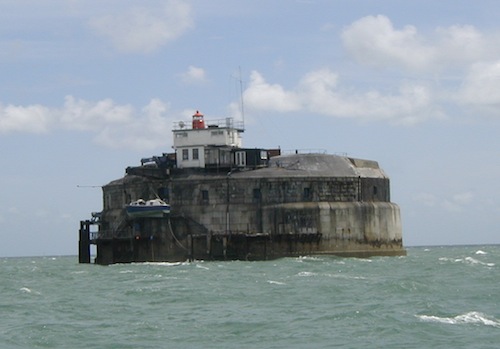
Lighthouses of England
Spit Sand Fort

Spit Sand Fort. Photo: Ken Trethewey (2004)
This visit to the Spit SandFort in 2004 was an unexpected bonus. As I work for the Royal Navy, we have occasional access to boats and on this Thursday we had arranged to cross the Solent to the Isle of Wight as part of a ‘team-building’ exercise. From the safety and solidity of solid ground, the weather seemed reasonable. There was a good amount of sunshine, with occasional showers, but the wind was blowing more than you might expect during high summer. Once we had left the harbour in Gosport Marina – near to the RN Submarine museum – and headed out through the narrow harbour entrance, it soon became clear that the trip would be uncomfortable. The sea was lumpy, with white wave tops – a clear sign of trouble for our twin-engine motor launch. As we steered a course for Cowes, we found ourselves heading directly into the stiff seas that created an action like riding a roller coaster, except that the lowest points were met with a heavy ‘thud’ on the keel of the boat. Turning in such conditions would have caused us serious danger of capsize as the boat was hit from the side by these waves, so there was option but to carefully turn back. With the sea now behind us, and not wishing to abandon our exercise altogether, we found that it was possible to head for the Spit Sand Fort, which we rounded comfortably before heading back for the calmer waters of the Portsmouth harbour.Portsmouth is, of course, a Naval port of very long standing and a large proportion of its traffic is made up of Royal Navy frigates, destroyers and aircraft carriers. However, it is also a busy cross-Channel port, with frequent sailings to France, as well as the many smaller ferries that service the Isle of Wight. Southampton-bound craft range from the desperately ugly steel boxes that transport thousands of cars into and out of England, through the merely moderately ugly container ships with their top-heavy profiles, to the amazingly beautiful cruise liners. The stretch of water between the Isle of Wight and the south coast of England is called the Solent. Large ships heading for Portsmouth and Southampton invariably use the channel that leads into the Solent around the eastern shore of the Isle of Wight. There are three such forts in the eastern approaches to the Solent.